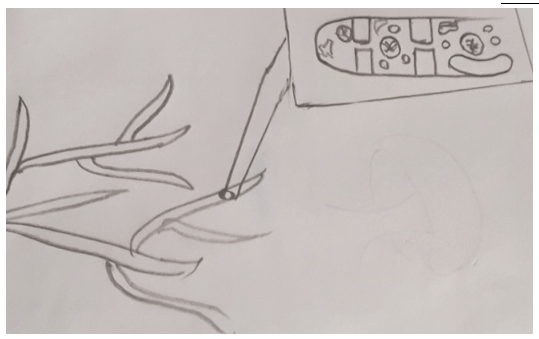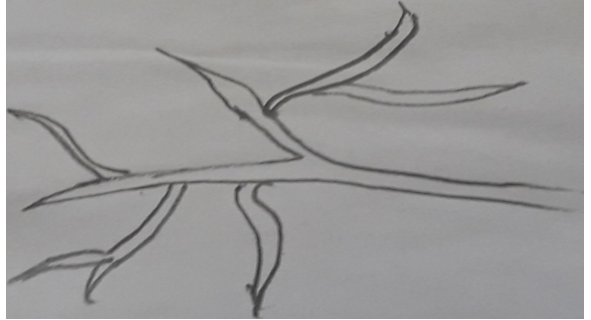This set of Class 11 Biology Chapter 2 Multiple Choice Questions & Answers (MCQs) focuses on “Biological Classification – Fungi – 1”.
1. Why do you think that food is protected from fungi when stored in refrigerator?
a) Fungi doesn’t grow in warm conditions
b) Refrigerator provides dry and cold conditions that don’t let fungi grow
c) Refrigerator contains CFC gas that is toxic and doesn’t let fungi to grow
d) Since the device works with electricity which doesn’t let fungus to grow
View Answer
Explanation: Fungi grow in moist and warm conditions. Refrigerator provides dry and cold conditions that prevent fungal growth. Therefore food stored in refrigerator doesn’t get rotten.
2. All fungi are multi-cellular.
a) True
b) False
View Answer
Explanation: All fungi are multi-cellular except yeast. Yeast is the only unicellular fungi. Yeast belong to Ascomycetes and are sometimes multi-cellular by formation of slender thread like structures called hyphae.
3. The structure shown below is the interconnection of ______

a) Hyphae
b) Dendrites
c) Rootlets
d) Rootlets
View Answer
Explanation: The above figure shows mycelium. Mycelium is the interconnection of slender thread like structures called hyphae. Fungi are differentiated based on the different mycelium that they possess.
4. Which among the following statements are incorrect about Fungi?
a) All the fungi are multi-cellular organisms except yeast
b) Fungi are heterotrophic and are either parasitic or saprophytic
c) Fungi prefer cold-dry conditions to grow
d) Fungi are immobile and this is the major difference between slime molds and that of fungi
View Answer
Explanation: Fungi prefer warm and moist conditions to grow. All the fungi are multi-cellular eukaryotic organisms except yeast. Fungi are heterotrophic and are either parasitic or saprophytic. Parasitic fungi sometimes cause diseases. Fungi are immobile and this is the major difference between slime molds and that of fungi.
5. Which among the following is wrong about the following figure?

a) Mycelium is made up of light thread like structures called hyphae
b) Hypha sometimes reproduces by vegetative reproduction
c) Mycelium is septate and coenocytic
d) Cell wall of fungi is made of chitin and polysaccharides
View Answer
Explanation: Mycelium is a network of light slender thread like structures called hyphae. Mycelium may be septate or aseptate i.e. either might be separated by septum or might not. Aseptate mycelium is coenocytic i.e. many nuclei share common cytoplasm. Cell wall of fungi is made of chitin and polysaccharides.
6. Lichens are __________
a) symbiotic existence of blue-green algae and fungi
b) symbiotic existence of rhizobium bacteria in the roots of leguminous plants
c) co-existence of coral reef with zooxanthellae
d) existence of mycorrhiza along with leguminous plants
View Answer
Explanation: Lichens are the co-existence of blue green algae with fungi. Fungus protects the algae from sun light. In turn algae provide nutrition for fungus since fungus cannot prepare its own food due to absence of chlorophyll.
7. Symbiosis between honey bee and flowers is an example of _________
a) Obligative symbiosis
b) Facultative symbiosis
c) Commensalism
d) Parasitism
View Answer
Explanation: In obligative symbiosis, both the organisms get benefitted and this symbiosis is necessary for both of their survival. Symbiotic relationship between honey bee and flowers is necessary for their survival because honey bees needs nectar from flowers and in turn help flowers with pollination.
8. Which among the following statements are incorrect?
a) Some parasitic fungi can cause disease in humans
b) Lichens are an example of obligative symbiosis
c) Lice in humans are example for endo-symbiosis
d) Cell wall of fungi is made of polysaccharides
View Answer
Explanation: Lice in humans are example of exo-symbiosis. Fungi are heterotrophic and can be either saprophytic or parasitic. Some of the parasitic fungi can cause diseases in humans. Lichens are an example of obligative symbiosis. Cell wall of fungi is made of chitin and polysaccharides.
9. Which among the following is incorrect about Dikaryon?
a) Dikaryon is formed by fusion of two nuclei
b) Dikaryon is haploid nuclei formed due to fusion of two nuclei
c) It further undergoes meiosis to form haploid cells
d) Dikaryon is formed only during adverse environmental conditions
View Answer
Explanation: Dikaryon is formed due to karyogamy. Sexual cycle of fungi comprises of 3 main steps: Plasmogamy, Karyogamy and Meiosis. Fungus prefers sexual reproduction over asexual reproduction during adverse environmental conditions. Initially, the cytoplasm of both the cells fuse which is called plasmogamy and followed by fusion of nuclei to form a diploid zygote called dikaryon. Later dikaryon undergoes meiosis in order to produce haploid spores.
10. Which among the following is not a mode of asexual reproduction?
a) Budding
b) Fragmentation
c) Zoospores
d) Zygospores
View Answer
Explanation: Fungus reproduces through asexual mode during favourable conditions and opts sexual mode of reproduction only during adverse situations. Budding, fragmentation and spore formation are different modes of asexual reproduction. Zoospores and zygospores are produced by phycospores for asexual and sexual odes of reproduction respectively.
11. Karyogamy means ______
a) fusion of nuclei
b) removal of cell wall
c) formation of new cell wall
d) division of nucleus
View Answer
Explanation: The word “karyo” means nucleus and “gamy” means fusion. Therefore the word “karyogamy” refers to the fusion of nuclei. In the sexual cycle of fungus to form spores, plasmogamy is followed by karyogamy and then by meiosis.
12. Diploid cell refers to __________
a) two set of chromosomes in a cell
b) germ cells in an organism
c) single set of chromosomes
d) double-membraned nuclei
View Answer
Explanation: Diploid cell refers to the cells with two set of chromosomes. Haploid cells refer to the cells that have only a single set of chromosomes. The number of chromosomes in a haploid cell is half that of a diploid cell. Germ cells are haploid.
13. Budding is ________
a) sexual mode of reproduction
b) an asexual mode of reproduction where an outgrowth from the parent splits to form the daughter organism
c) an asexual mode of reproduction where the parent organisms splits into fragments and then develops into a new organism
d) an asexual mode of reproduction where cytoplasm and nuclei splits into two equal parts to form two daughter nuclei
View Answer
Explanation: Budding is an asexual mode of reproduction where an outgrowth from the parent splits to form the daughter organism. Fragmentation is another mode of asexual reproduction where the parent organisms splits into fragments and then develops into a new organism. Binary fission is an asexual mode of reproduction where cytoplasm and nuclei splits into two equal parts to form two daughter nuclei.
14. During reproduction of fungus through fragmentation, ______
a) Mycelium separates into pieces which in turn form new one
b) Germ cells separate into pieces which in turn form new one
c) Zoospores are formed which further germinates to form new mycelium
d) Zygospores are formed which further germinates to form new mycelium
View Answer
Explanation: During reproduction of fungus through fragmentation, Mycelium separates into pieces which in turn grow to form new mycelium. Fragmentation is one of the most common modes of asexual reproduction in Basidiomycetes.
15. Coenocytic means _______
a) sharing of common cytoplasm
b) removal of plasma membrane
c) sharing of common nucleus
d) sharing of common hyphael wall
View Answer
Explanation: The word “coeno” means common and “cytic” means cytoplasm. Therefore the word “coenocytic” means sharing of common cytoplasm. Aseptate fungi have multiple nuclei in a common cytoplasm.
Sanfoundry Global Education & Learning Series – Biology – Class 11.
To practice all chapters and topics of class 11 Biology, here is complete set of 1000+ Multiple Choice Questions and Answers.
If you find a mistake in question / option / answer, kindly take a screenshot and email to [email protected]
- Check Class 11 - Books
- Practice Class 12 - Biology MCQs
- Practice Class 11 - Physics MCQs
- Practice Class 11 - Mathematics MCQs
- Practice Class 11 - Chemistry MCQs
